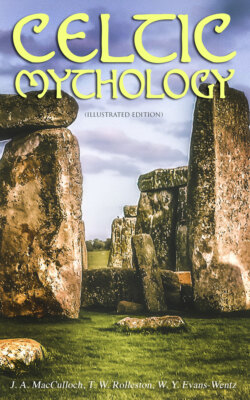Читать книгу CELTIC MYTHOLOGY (Illustrated Edition) - T. W. Rolleston - Страница 8
The Sack of Rome
ОглавлениеWe have mentioned two of the great wars of the Continental Celts; we come now to the third, that with the Etruscans, which ultimately brought them into conflict with the greatest power of pagan Europe, and led to their proudest feat of arms, the sack of Rome. About the year 400 B.C. the Celtic Empire seems to have reached the height of its power. Under a king named by Livy Ambicatus, who was probably the head of a dominant tribe in a military confederacy, like the German Emperor in the present day, the Celts seem to have been welded into a considerable degree of political unity, and to have followed a consistent policy. Attracted by the rich land of Northern Italy, they poured down through the passes of the Alps, and after hard fighting with the Etruscan inhabitants they maintained their ground there. At this time the Romans were pressing on the Etruscans from below, and Roman and Celt were acting in definite concert and alliance. But the Romans, despising perhaps the Northern barbarian warriors, had the rashness to play them false at the siege of Clusium, 391 B.C., a place which the Romans regarded as one of the bulwarks of Latium against the North. The Celts recognised Romans who had come to them in the sacred character of ambassadors fighting in the ranks of the enemy. The events which followed are, as they have come down to us, much mingled with legend, but there are certain touches of dramatic vividness in which the true character of the Celts appears distinctly recognisable. They applied, we are told, to Rome for satisfaction for the treachery of the envoys, who were three sons of Fabius Ambustus, the chief pontiff. The Romans refused to listen to the claim, and elected the Fabii military tribunes for the ensuing year. Then the Celts abandoned the siege of Clusium and marched straight on Rome. The army showed perfect discipline. There was no indiscriminate plundering and devastation, no city or fortress was assailed. “We are bound for Rome” was their cry to the guards upon the walls of the provincial towns, who watched the host in wonder and fear as it rolled steadily to the south. At last they reached the river Allia, a few miles from Rome, where the whole available force of the city was ranged to meet them. The battle took place on July 18, 390, that ill-omened dies Alliensis which long perpetuated in the Roman calendar the memory of the deepest shame the republic had ever known. The Celts turned the flank of the Roman army, and annihilated it in one tremendous charge. Three days later they were in Rome, and for nearly a year they remained masters of the city, or of its ruins, till a great fine had been exacted and full vengeance taken for the perfidy at Clusium. For nearly a century after the treaty thus concluded there was peace between the Celts and the Romans, and the breaking of that peace when certain Celtic tribes allied themselves with their old enemy, the Etruscans, in the third Samnite war was coincident with the breaking up of the Celtic Empire.10
Two questions must now be considered before we can leave the historical part of this Introduction. First of all, what are the evidences for the widespread diffusion of Celtic power in Mid-Europe during this period? Secondly, where were the Germanic peoples, and what was their position in regard to the Celts?
